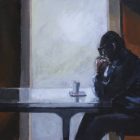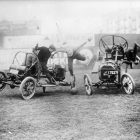The Best Short Story I Read in a Lit Mag This Week: “Ghost Jeep” by Micah Dean Hicks
When one deals with loss they also, inevitably, also end up exploring the nature of justice in the world: whether matters of life and death are indeed fair, or something else entirely.
In “Ghost Jeep,” (Sycamore Review) Micah Dean Hicks navigates these questions through three ghosts who meet a young girl who wants to become one of them.
Hicks opens the story by exploring the world of the ghosts—rendered in first-person plural—who for twenty years after a horrible auto accident have been haunting the small town they grew up in by night. But this pattern is soon interrupted by an inciting incident, in the form of an unexpected visitor.
For weeks, someone new has been watching. A girl waits by the road for us to pass. We don’t see her there in the dark until our lights slide over her.
They don’t stop for the girl, instead continue on to their usual haunts—one to visit an old crush who’s long since left town, another to look for an old dog: “He walks around the yard and calls to his old dog for hours, until the sky begins to brighten, but that dog is deader than we are.” It’s with scenarios like these that Hicks subverts the typical thin “monster” interpretation of ghosts for a more complex one. Ghosts are by nature tragic, but these are fully aware of the fruitlessness of their endeavors, while at the same time are unable to change them. Their tragedy—and the reader’s empathy for them—increases proportionately with the level of their self-awareness.
The next night, the girl on the side of the road slings gravel against the truck. The ghosts stop and pick her up and begin peppering her with questions.
“But who are your friends?” We want to know who she stands next to at lunch, which houses she spends the night at, whether she hangs out at the mall or the theater or the basketball courts. We want to file her away with the people we know so that we can hate her, too, tell her that she’s just like everyone else, that we don’t want her in our jeep.
These ghosts are closed off. They’re looking for reasons not to connect with her. But Hicks reveals that the girl doesn’t really have any friends, nor does she have a home life she’s in any hurry to return to…in other words, she has a lot in common with them.
Watch how Hicks details their growing affection towards her through the middles scenes of the story. First, when they go out to skip rocks on a lake and lose sight of the girl.
We can’t see her anymore. We shout for her to be careful, and for a moment, we all remember how it feels to lose something.
…then, right before sunrise:
We drop her off (at home) and watch her go inside. There are not cars in her driveway, and we worry about her, not used to the feeling.”
…and finally, the next day, when they pick her up again and lend her ghost glasses to watch a decades-old flick in a movie theater that no longer exists.
We watch her face and feel what she feels, emotions we lost a long time ago and can’t name.
This intimacy paves the way for further revelation of what happened to the ghosts; now that they are fond of the girl, they open up about what happened all those years ago. It turns out the wreck of the ghost jeep was a shared accident—neither party, the three in the jeep or the girl in the SUV, was paying attention to the road.
But what happened afterward was not. The girl in the SUV was the sheriff’s daughter. Even though she wasn’t hurt nearly as bad as the three in the jeep, at the scene of the accident, the sheriff decided to send her in the first ambulance to the hospital and make the three in the jeep wait for the next one. They died, and revenge for this is what causes them to become ghosts.
Hicks’s complex plot comes to a climax when the girl decides to ride along with them during the night of the accident, despite the pleas of the ghosts not to. When the car wrecks, she’s deeply injured, and they rush her to the hospital, where it turns out, the sheriff’s daughter—the girl in the SUV—is now a doctor that they’ve been haunting for years. They urge her to come out, but she’s hesitant. Here’s why:
…when she sees us, she starts to cry. Some nights, we follow her all over town, giving her no peace and not letting her forget for a second why she is alive.
We shout for her to save the girl.
She can’t hear us through the glass, and she doesn’t understand. Like always, she mouths, “It wasn’t my fault. I didn’t want this.”
They keep trying and trying, and eventually she comes out to help. But by then—like that second ambulance twenty years ago—it’s too late. The sun comes up and the ghosts disappear, unable to direct the doctor to where the girl is lying injured.
So what of justice? I’d suggest Hicks—like the ghosts—is presenting a world in which both life and death are unfair. But that doesn’t mean they aren’t both poetic.
About Author
Ross McMeekin’s stories appear or are forthcoming in journals such as Virginia Quarterly Review, Post Road Magazine, Shenandoah, Redivider, and Tin House (online). He edits the literary journal Spartan. He has received fellowships from both the Jack Straw Cultural Center and Richard Hugo House in Seattle.




